Calendar of upcoming events.
Click on the Image for more Info

Open Studio Time -
Book an Open Studio session at Aya Fiber Studio in Stuart, FL. Work independently with our dye kitchen, print tables, indigo vats, and sewing machines. $40 half day / $60 full day. Limited spots.

Selective De-gumming on Raw Silk
Learn selective degumming on silk organza at Aya Fiber Studio in Stuart, FL. Explore shibori resist, indigo dyeing, and silk surface design techniques to create textured, patterned fabrics in this hands-on fiber art workshop.

Open Studio Time
Book an Open Studio session at Aya Fiber Studio in Stuart, FL. Work independently with our dye kitchen, print tables, indigo vats, and sewing machines. $40 half day / $60 full day. Limited spots.




Intro to Shibori and Indigo
Indigo is an ancient dye derived from the leaves of plants and surrounded by magic, mystery, and folklore. Discover how the leaves ‘make blue’ by learning about the character and chemistry of the natural indigo vat.
The complex chemistry of the indigo vat is fascinating and students will soon appreciate how rituals have grown around the making and using of a successful vat. The unique ‘attaching’ of indigo to fiber means it is particularly suited to resist methods of dying, such as shibori, where portions of cloth are closed off to the dye or where the flow of dye is restricted. Different shades of blue build on the fabric after several dips, exhibiting the beautiful graded hues that are so typical of indigo.
SKILLS/TECHNIQUES COVERED: Students will initially learn how an indigo vat is made. A vat will be prepared in the morning and the basic chemistry explained. The natural indigo powder will be used, and the vat will be ‘reduced’ using a commercially available chemical. While the vat develops, students will be shown several shibori techniques: a folded and clamped method, and a twisted and tied technique.
LEVEL: Beginner and intermediate
LOCATION: STUART STUDIO
Students will be given authentic Japanese tenugi fabric for class instruction
https://ayafiberstudio.corsizio.com/event/674884f4aa4a191770efdd16
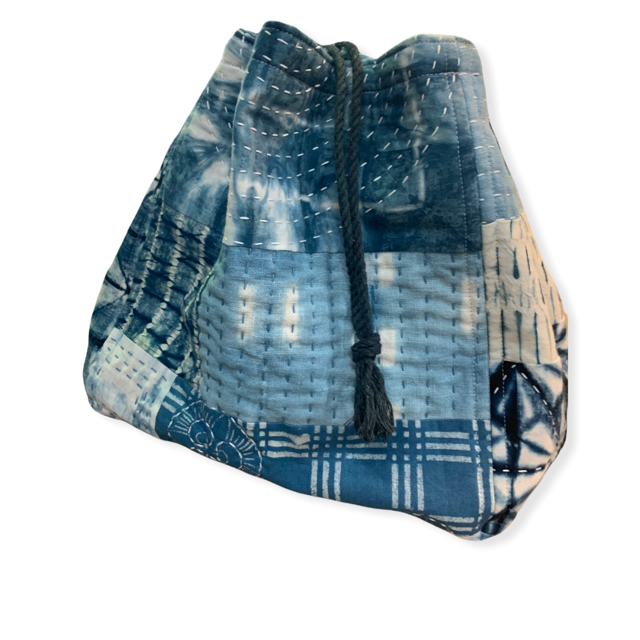
Komebukuro: Crafting a Cultural Keepsake
Create a beautiful and functional komebukuro—a traditional Japanese rice bag—using fabrics that hold personal meaning or aesthetic appeal. These charming drawstring bags were originally used to carry offerings of rice to temples, and today they make lovely gift bags, project pouches, or keepsake carriers.
In this hands-on workshop, you’ll learn how to piece, stitch, and construct your own fully lined rice bag using a simple boxed-base method. We'll cover design layout, fabric pairing, basic construction, and finishing techniques. You'll leave with a completed bag and the skills to make many more.

Open Studio Time
Open Studio Sessions- (11th not shown on calendar)
12/10/2025- 12/11/2025 10:00 early session 1:30 late session
Complete those last-minute Christmas gifts!

Wine, Warp & Weft
Join us for Wine, Weave & Warp at Aya Fiber Studio — a creative evening of color, craft, and connection! Enjoy a glass of wine while learning handweaving on classic loop looms. Perfect for beginners, this fun social workshop combines relaxation, creativity, and handmade charm. All materials and a complimentary glass of wine included.

Aya Fiber Studio Holiday OPEN HOUSE
Handcrafted Holidays at Aya 💙
You’re invited to a cozy, creative Holiday Open House at
the Aya Fiber Studio!
✨ Preview Night: Friday, December 12 · 6–8 PM
🌿 Open House Weekend: Saturday–Sunday, December 13–14 · 11 AM–4 PM
Celebrate the season with indigo, texture, and handmade gifts. Join us for an evening preview and weekend open house featuring fiber-art demos, small-batch textiles, and gift ideas for every maker.
Enjoy a festive, creative atmosphere and see what’s new at Aya Fiber Studio.
December 12, 2025 6-8:30 pm
December 13-14, 2025 11:00 am- 4:00 pm
170 NE Dixie Hwy
Stuart, FL 34994

Open Studio Time
Open Studio Sessions-
12/15/2025- 12/19/2025 10:00 early session 1:30 late session
Complete those last-minute Christmas gifts!

Mimosa’s and Mending: A Slow Stitch social at Aya Fiber Studio
Mimosas & Mending at Aya Fiber Studio is a relaxed, creative social event where you can repair, refresh, and upcycle your favorite clothing using hand-stitching, sashiko, patchwork, and visible mending techniques. Enjoy a morning of slow stitching, community connection, and—of course—fresh mimosas. Bring denim, jeans, or well-loved garments and leave with beautiful repairs and new skills. Perfect for beginners and seasoned makers.

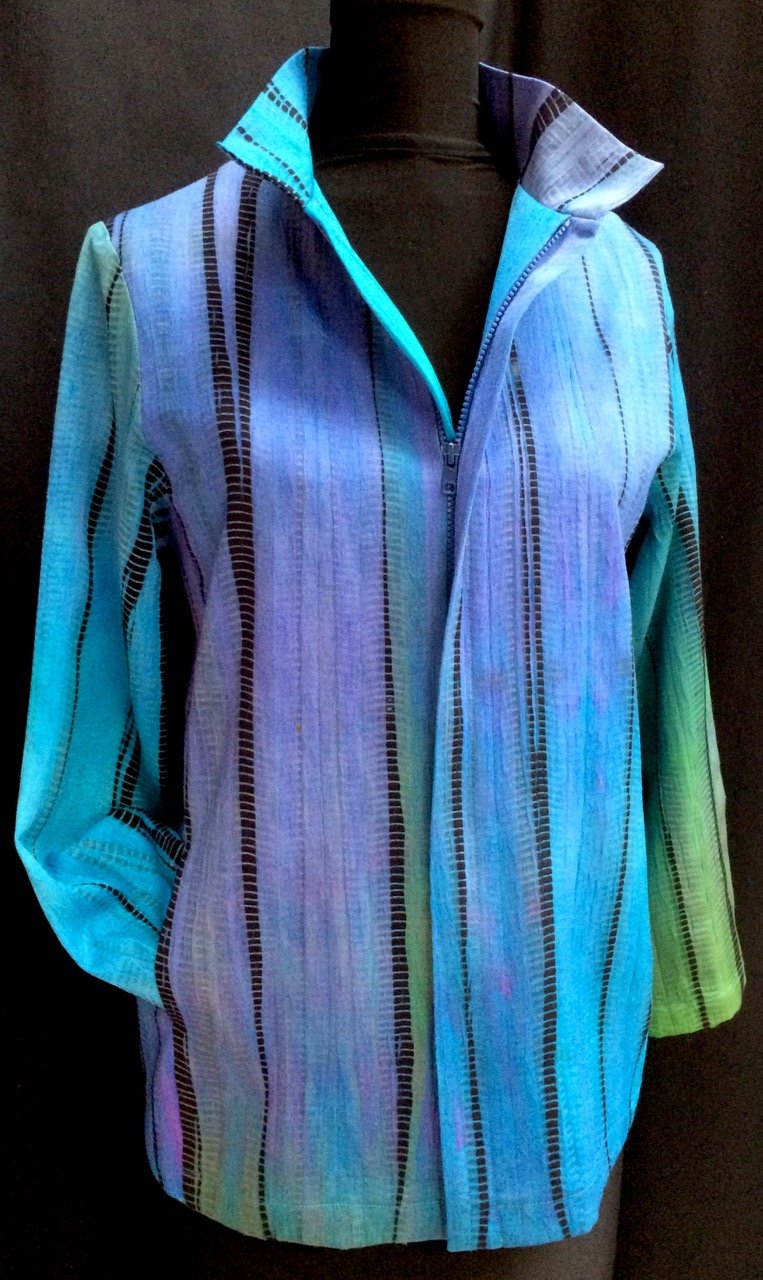
Depth and Mystery in Shibori with DOSHI
Explore Shibori, where chance and material guide the dyeing process. Learn resist techniques, layering, discharge, and acid dyeing on silk to create rich, textured, and vibrant fabrics.

Lisa Binkley
The Colorful Chemistry of Plants: A Botanical Printing Workshop—Bring a favorite plant to life and explore its beauty on fabric in this hands-on, creative immersion.

Open Studio Time
Open Studio Sessions-
1/15- 1/16/2026 10:00 early session 1:30 late session
Get some extra Botanical Printing in after Lisa’s Workshop!


Intro to Shibori and Indigo
Indigo is an ancient dye derived from the leaves of plants and surrounded by magic, mystery, and folklore. Discover how the leaves ‘make blue’ by learning about the character and chemistry of the natural indigo vat.
The complex chemistry of the indigo vat is fascinating and students will soon appreciate how rituals have grown around the making and using of a successful vat. The unique ‘attaching’ of indigo to fiber means it is particularly suited to resist methods of dying, such as shibori, where portions of cloth are closed off to the dye or where the flow of dye is restricted. Different shades of blue build on the fabric after several dips, exhibiting the beautiful graded hues that are so typical of indigo.
SKILLS/TECHNIQUES COVERED: Students will initially learn how an indigo vat is made. A vat will be prepared in the morning and the basic chemistry explained. The natural indigo powder will be used, and the vat will be ‘reduced’ using a commercially available chemical. While the vat develops, students will be shown several shibori techniques: a folded and clamped method, and a twisted and tied technique.
LEVEL: Beginner and intermediate
LOCATION: STUART STUDIO
Students will be given authentic Japanese tenugi fabric for class instruction
https://ayafiberstudio.corsizio.com/event/674884f4aa4a191770efdd16

Visual Haiku with Flax Fiber Collage with Jacqueline Mallegni
Explore Wabi-Sabi through flax roving and natural materials, creating collages and visual haiku. Experiment with texture, mark-making, and materiality to express place and self creatively.

Develop a Personal Artistic Vocabulary on Paper with Claudia Lee
Our focus for this workshop will be for each student to develop their own personal design vocabulary on which to build a body of work.
This vocabulary will take the form of text, images and a personal color palate that will be developed through the exploration of surface design techniques including wax resist, mono-printing on a gel plate, paste papers, image transfers, collage, stitching, mark-making and more.
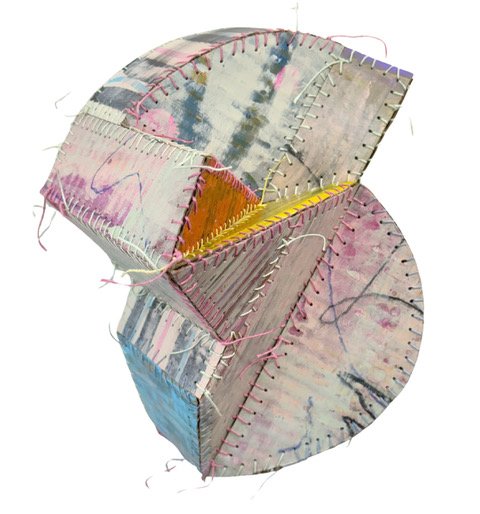
Sculptural Stitchery Instructor: Susan Stover
Merging the detailed nature of stitching and the physical, three-dimensional aspects of sculpture, is the focus of this workshop.
We’ll examine how traditional and nontraditional hand stitching methods can play a powerful role, conceptually and materially, in sculpture. By introducing a rich historical context, inspiration from contemporary artists, and a tangible experience, we’ll explore new possibilities for your work.

Interaction! Shibori Indigo Over Color with Carol Anne Grotrian
Experience the excitement of dyeing indigo patterns over color. Results can range from dramatic to subtle, with a bonus when the interaction of indigo and fiber-reactive dyes creates interesting haloes of color. The class will include instructions on mixing fiber-reactive colors and using an indigo vat and various Shibori techniques. There will be lots of time to create beautiful, unique fabrics as students team up to create solid colors that everyone can overdye in indigo shibori patterns.
While it is NOT required, students are encouraged to come up with a project in mind, such as a wall hanging, quilt, garment, or other textile.
No experience is necessary; experienced dyers are welcome.


Katazome- Japanese Rice Paste Resist
The traditional Japanese art of katazome is ancient. Kata means stencil and zome is a form of the word someru which means to dye- hence katazome (stencil dyeing)
The basic process of stencil dyeing is not complicated. First, a stencil is cut and placed on a piece of fabric. Next resist paste is applied through the stencil.
The stencil is then removed, and the pasted fabric is allowed to dry in the sunlight. Fabric is then treated with sizing if going to be dyed with pigments. Fabric is then indigo dyed or the color pigments brushed on.
Finally, the fabrics are soaked in water to remove the paste.
The steps of creating Katazome must be followed in sequence, and timing is essential.


Light and Lacy with Valerie Goodwin
Create lovely collages using shapes such as map elements, floral motifs, and /or geometric patterns and shapes using opaque and sheer fabrics.
Explore the potential of intricately cut surfaces created with the Silhouette Cameo electronic cutter. This popular machine can provide precision cutting that leads to beautiful detail.
The instructor will also provide the opportunity to work with elements that are pre-cut with a laser cutter.




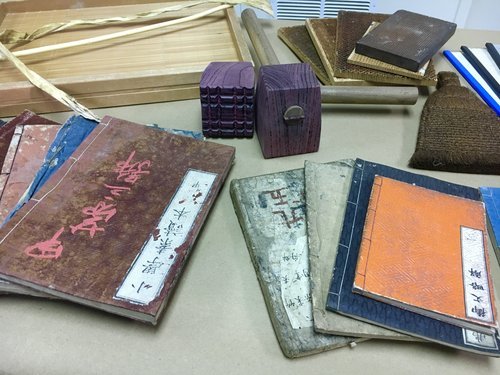
Japanese Papermaking & Bookbinding Intensive with Anne Covell
The Japanese Paper-making & Bookbinding Intensive is designed to give students the unique opportunity to learn three distinct Japanese crafts: Nagashizuki hand papermaking, natural dyeing and cover decoration, and hand bookbinding. Each day, we will build upon skills learned in previous sessions to create a body of work that is considerate of the resources, materials, and aesthetics that define Japanese bookmaking. Students can expect to leave this workshop with a collection of hand-bound books housed as well as a stack of luscious hand-dyed decorative papers to use for further exploration.

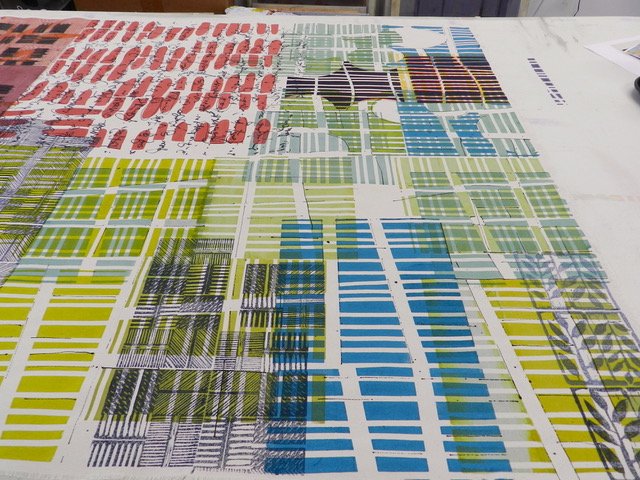



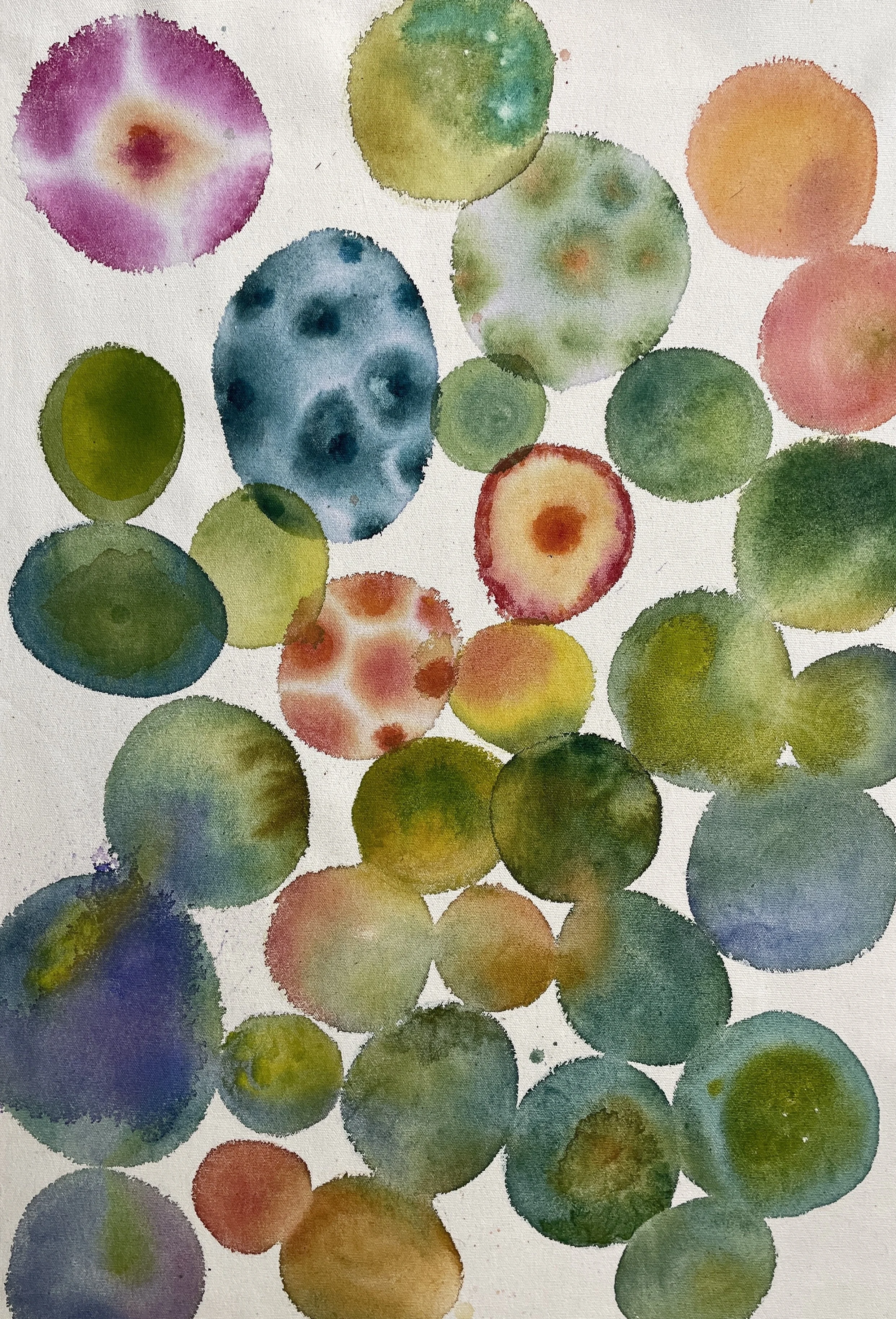
Surface Design w Betty Busby
Welcome to my new techniques class!
We’ll cover multiple new ways of expressing ourselves on fabric.
Transfer printing: we’ll use non-toxic dye (provided by me) to transfer designs from paper to synthetic materials, using heat.
It’s a very different way of creating designs, as compositions can be created on dry paper with collage techniques.
A huge variety of synthetic materials can be used, including sheers.
Also, botanicals can be used with fantastic results, matching or exceeding results achieved through eco printing. Post production: learn how to use various media such as gel pens, markers, and colored pencils, to enhance your stitching after quilting.
Watercolor techniques on fabric: We’ll use fabric paints on cotton to achieve similar effects of watercolor paint on paper, only it is permanent. These can make a great base for hand or machine stitching.


DYE PAINT YOUR IMAGES / BRING THEM TO LIFE WITH QUILTING with Hollis Chatelain
In this workshop, you will first learn how to paint images with Procion dyes on cotton. Learning to control the dyes will be emphasized. Among other things, we will cover blending, layering, special effects and painting without bleeding. All of these techniques can be used to create images as complex as portraits or as simple as a line on a scarf. Each student is asked to bring two or three 18"x 20" designs or drawings that they will transfer onto cloth and then paint. These drawings can be fruits or rounded objects, still life, animals, faces, or anything you would like to paint. Any image can be used as long as it has been made into an 18" X 20" black and white line drawing. It would also help to have an example or an idea of your color choices. In the second part of the workshop, we will explore new ideas about how to use quilting to enhance the look of your painted cloth. The main objective is to use quilting lines to create depth, texture, tension, or shadowing which will give a new dimension to your quilt. Lines can be inspired by an endless variety of things (nature, architecture, technology, etc.) to add visual interest and reinforce your overall design. Even straight lines can become a design in themselves. You will be working with the images you have painted during the first part of the workshop. This workshop is based on free-motion machine quilting but the design techniques can be adapted to hand quilting. Experience in one or the other is required.


INTRO TO ECO-PRINT
Instructor: Suzanne Connors
Come experience the magic that happens when Eco-Printing.
Eco Printing is a process of using plants to dye and print on fiber using direct contact printing methods
During our workshop’s; participants will explore the alchemy of water, plant materials, heat, and metal and finish the class with beautiful prints on protein fibers.
In these workshop's we will be creating samples and experimenting with different protein fibers ( silk, wool). I will show you processes that have worked well for me and the equipment and bundling techniques that are used.
Although students are asked to bring a variety of leaves to class, we will also forage to identify and collect plants for printing. Emphasis will be placed on safety, best practice procedures, environmental factors and plant characteristics.
The final project will be printing on a 14” x 72” silk scarf.
This is a relaxed, fun-filled class so come prepared for the wonderful smells that can only come from eucalyptus, and other natural leaves and be open to the magic
The Intro 1-Day workshop will cover:
The materials and equipment needed for eco-printing
Fabric selections & prep (please pre scour fabrics prior to class)
Choosing the right plants for dyeing and understanding the role tannin plays
Understanding the print process on protein fibers ( we will be using protein fibers only in this workshop, for use of cellulose fibers- please check out the 3 day class)
Preparing the leaves for contact printing
Different techniques for laying out your leaves
Methods of rolling, tying and cooking bundles
https://ayafiberstudio.corsizio.com/c/641eff2b2effb6344884886e

3 Day Botanical Print Workshop
Instructor: Suzanne Connors
Eco Printing is a process of using plants to dye and print on fiber through contact printing methods. Botanical Printing is the additional of using natural dyes for added color.
During our workshop’s; participants will explore the alchemy of water, plant materials, heat, and metal and finish the class with beautiful prints on natural fiber fabrics.
In these workshop's we will be creating samples and experimenting with different fibers. We will be using natural plant materials gathered near my Florida home or brought with you from your garden. I will show you processes that have worked well for me and the equipment and bundling techniques that are used.
Be prepared for the wonderful smells that can only come from eucalyptus, and other natural leaves and be open to the magic
The 3-Day workshop will cover:
THE MATERIALS AND EQUIPMENT NEEDED FOR ECO-PRINTING
FABRIC SELECTIONS & PREP (PLEASE PRE SCOUR FABRICS PRIOR TO CLASS)
CHOOSING THE RIGHT PLANTS FOR DYEING AND UNDERSTANDING THE ROLE TANNIN PLAYS
UNDERSTANDING THE PRINT PROCESS ON BOTH PROTEIN & CELLULOSE FIBERS
MORDANTING COTTON & LINEN FIBERS: we will discuss methods of mordanting cellulose fabrics and mordant all fabrics on day 1
DIFFERENT METHODS OF PREPARING THE LEAVES FOR CONTACT PRINTING
DIFFERENT TECHNIQUES FOR LAYING OUT YOUR LEAVES
METHODS OF ROLLING, TYING AND COOKING BUNDLES
BUNDLING OVER SIZED FIBER AND CLOTHING
USING DYE BLANKETS TO GET BACKGROUND COLOR
INDIGO AND ECO PRINT
Class Time: 9:00 am-4:00pm
Web Link: https://ayafiberstudio.corsizio.com/c/6398aaaa37c937a7d807ee72


Kawandi- Sujata Shah
Kawandi – A utilitarian quilt made with found and collected scraps by the African Diaspora of India.
Document the memories and special events of life with stitches. From start to finish, this is a complete hand-stitching project. The focus of this workshop will be on being spontaneous while selecting scraps and learning to personalize simple patchwork by using colors and fabric from your life. Sujata will share how to find the rhythm of your own between your mind and body and practice mindful stitching.
In this five-day-long retreat, you will learn the elements of design in Kawandi and the background of people who originally inspired this art form. Sujata will also share her personal experiences growing up in India and life after moving to the United States as a colorist and a designer.

Morakami (Copy) (Copy)
Katazome Workshop
https://morikami.org/event/shibori-indigo-workshop/

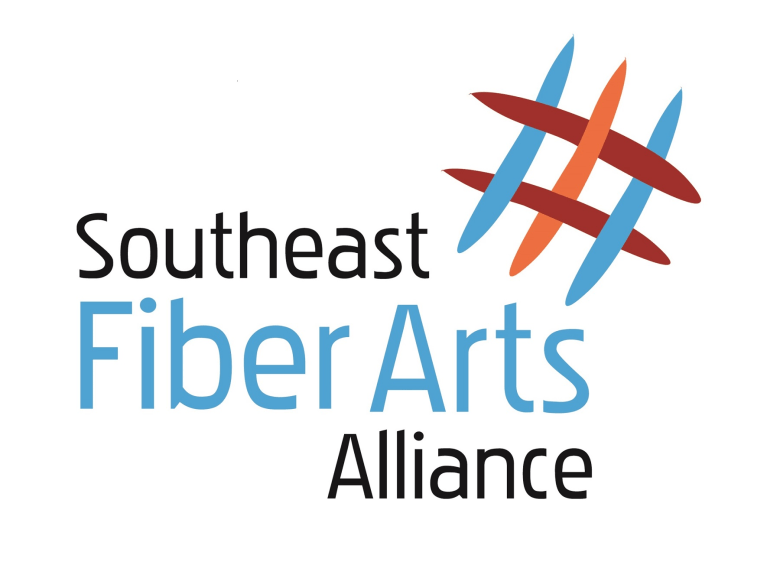

Madeline Island Workshop
Suzanne Connors will teaching at the Madeline Island School of Arts; July 13-17, 2026

Appalachian Center of Craft Workshop
The mission of the Appalachian Center for Craft is to promote excellence in American craft by teaching both tradition and innovation in professional studio craft, and fostering access to the highest quality craft education, craft artists, craft works and events in a community arts context.

Katazome - Sanborn Mills
Suzanne Connors will be teaching at Sanborn Mills Farm; August 12-17, 2026

Japan Textile Trip FALL 2027
This exclusive Textile tour offers a unique opportunity to immerse yourself in the profound tradition and beauty of Japanese indigo dyeing and traditional Japanese Craft. Tailored for both beginners and experienced textile artists, the workshops are meticulously designed to provide comprehensive knowledge and hands-on practice. Participants will gain an in-depth understanding of the intricate process of creating the deep, rich blue hues that indigo is renowned for, ultimately fostering a profound appreciation for this ancient craft. Whether your goal is to enhance your artistic skills or indulge in a cultural experience, this program promises to be both enlightening and unforgettable.
Throughout this journey, participants will engage in multiple private hands-on indigo sessions. You will learn the complex process of making sukumo, the traditional Japanese compost method of producing indigo dye, which involves the fermentation of indigo leaves to create a natural dye. Additionally, you will explore various resist dyeing techniques such as stencil cutting and katazome, which utilizes rice paste to create detailed patterns; kasuri, a Japanese ikat technique known for its distinctive, blurred designs; and shibori, an ancient tie-dye resist method that results in exquisite, organic patterns.
Participants will have the opportunity to interact with a diverse range of individuals deeply connected to the art of indigo dyeing. This includes indigo farmers who cultivate the plants, ‘National Living Treasure’ artisans recognized for their exceptional craftsmanship, innovative young practitioners who are redefining traditional techniques, artists who incorporate indigo into their works, and experts and collectors who possess a deep appreciation for indigo textiles.
Be inspired by the remarkable design and craftsmanship showcased during visits to specialist indigo museums, galleries, and studios. Attendees will benefit from insightful talks by artisans, offering an in-depth look into the history and evolution of indigo dyeing. For those interested, there will also be opportunities to purchase stunning indigo textiles and handcrafted items, each piece reflecting the dedication and skill of its creator.
Beyond the hands-on indigo experiences, participants will have the chance to immerse themselves in Japan's rich cultural heritage. This includes participating in a traditional tea ceremony, which epitomizes the principles of harmony, respect, purity, and tranquility. Additionally, visits to magnificent temples and shrines, each with unique architecture and history, will be arranged. Cultural sites in Kyoto, Tokushima, and Kurume—cities lauded for their historical significance and beauty—will also be explored. We will also discover Okayama's historic sites and gardens, followed by Naoshima Island’s art museums.
Join us for an experience of traditional Japanese culture and hospitality, in the company of a small group of like-minded textile and indigo enthusiasts. This journey is not merely about acquiring a new craft; it is about connecting with a rich cultural heritage and becoming part of a community united by a shared passion for indigo.

Open Studio Time
Book an Open Studio session at Aya Fiber Studio in Stuart, FL. Work independently with our dye kitchen, print tables, indigo vats, and sewing machines. $40 half day / $60 full day. Limited spots.



Open Studio Time
Book an Open Studio session at Aya Fiber Studio in Stuart, FL. Work independently with our dye kitchen, print tables, indigo vats, and sewing machines. $40 half day / $60 full day. Limited spots.

Open Studio Time
Book an Open Studio session at Aya Fiber Studio in Stuart, FL. Work independently with our dye kitchen, print tables, indigo vats, and sewing machines. $40 half day / $60 full day. Limited spots.
Coffee with the Artist- Lisa Binkley
Hi there,
You are invited to a Zoom meeting.
When: October 19, 2025, 09:00 AM Eastern Time (US and Canada)
Register in advance for this meeting:
https://us02web.zoom.us/meeting/register/wiOZXrR-S-2liNg0vXrYAA
After registering, you will receive a confirmation email containing information about joining the meeting.

Open Studio Time
Book an Open Studio session at Aya Fiber Studio in Stuart, FL. Work independently with our dye kitchen, print tables, indigo vats, and sewing machines. $40 half day / $60 full day. Limited spots.

Open Studio Time
Book an Open Studio session at Aya Fiber Studio in Stuart, FL. Work independently with our dye kitchen, print tables, indigo vats, and sewing machines. $40 half day / $60 full day. Limited spots.

Open Studio Time
10:00 early session
Drop-In Fee: $40/ session ( morning/ afternoon) $60/ all day
(Limit 5 people per session, 1 per large table)
Materials Fee: Charged per session
Indigo Vat Refresh for existing vats: $10 (Freshen existing vats or make your own. Buying a pre-reduced Indigo kit is recommended if a vat isn't available.)
Propane Use for Dyeing and Eco-printing: $8/session
Dyes & Mordants: Available for purchase, pre-measured by the gram
Bring Your Materials: (string, threads, dyes, indigo, etc.)
Studio Equipment:
1 person per 4’ x 8’ table
Use dye pots, dye equipment, Shibori supplies, and sewing machines

Intro to Shibori and Indigo
Indigo is an ancient dye derived from the leaves of plants and surrounded by magic, mystery, and folklore. Discover how the leaves ‘make blue’ by learning about the character and chemistry of the natural indigo vat.
The complex chemistry of the indigo vat is fascinating and students will soon appreciate how rituals have grown around the making and using of a successful vat. The unique ‘attaching’ of indigo to fiber means it is particularly suited to resist methods of dying, such as shibori, where portions of cloth are closed off to the dye or where the flow of dye is restricted. Different shades of blue build on the fabric after several dips, exhibiting the beautiful graded hues that are so typical of indigo.
SKILLS/TECHNIQUES COVERED: Students will initially learn how an indigo vat is made. A vat will be prepared in the morning and the basic chemistry explained. The natural indigo powder will be used, and the vat will be ‘reduced’ using a commercially available chemical. While the vat develops, students will be shown several shibori techniques: a folded and clamped method, and a twisted and tied technique.
LEVEL: Beginner and intermediate
LOCATION: STUART STUDIO
Students will be given authentic Japanese tenugi fabric for class instruction
https://ayafiberstudio.corsizio.com/event/674884f4aa4a191770efdd16

3 Day Botanical Print Workshop
Instructor: Suzanne Connors
Eco Printing is a process of using plants to dye and print on fiber through contact printing methods. Botanical Printing is the additional of using natural dyes for added color.
During our workshop’s; participants will explore the alchemy of water, plant materials, heat, and metal and finish the class with beautiful prints on natural fiber fabrics.
In these workshop's we will be creating samples and experimenting with different fibers. We will be using natural plant materials gathered near my Florida home or brought with you from your garden. I will show you processes that have worked well for me and the equipment and bundling techniques that are used.
Be prepared for the wonderful smells that can only come from eucalyptus, and other natural leaves and be open to the magic
The 3-Day workshop will cover:
THE MATERIALS AND EQUIPMENT NEEDED FOR ECO-PRINTING
FABRIC SELECTIONS & PREP (PLEASE PRE SCOUR FABRICS PRIOR TO CLASS)
CHOOSING THE RIGHT PLANTS FOR DYEING AND UNDERSTANDING THE ROLE TANNIN PLAYS
UNDERSTANDING THE PRINT PROCESS ON BOTH PROTEIN & CELLULOSE FIBERS
MORDANTING COTTON & LINEN FIBERS: we will discuss methods of mordanting cellulose fabrics and mordant all fabrics on day 1
DIFFERENT METHODS OF PREPARING THE LEAVES FOR CONTACT PRINTING
DIFFERENT TECHNIQUES FOR LAYING OUT YOUR LEAVES
METHODS OF ROLLING, TYING AND COOKING BUNDLES
BUNDLING OVER SIZED FIBER AND CLOTHING
USING DYE BLANKETS TO GET BACKGROUND COLOR
INDIGO AND ECO PRINT
Class Time: 9:00 am-4:00pm
Web Link: https://ayafiberstudio.corsizio.com/c/6398aaaa37c937a7d807ee72

INTRO TO ECO-PRINT
Instructor: Suzanne Connors
Come experience the magic that happens when Eco-Printing.
Eco Printing is a process of using plants to dye and print on fiber using direct contact printing methods
During our workshop’s; participants will explore the alchemy of water, plant materials, heat, and metal and finish the class with beautiful prints on protein fibers.
In these workshop's we will be creating samples and experimenting with different protein fibers ( silk, wool). I will show you processes that have worked well for me and the equipment and bundling techniques that are used.
Although students are asked to bring a variety of leaves to class, we will also forage to identify and collect plants for printing. Emphasis will be placed on safety, best practice procedures, environmental factors and plant characteristics.
The final project will be printing on a 14” x 72” silk scarf.
This is a relaxed, fun-filled class so come prepared for the wonderful smells that can only come from eucalyptus, and other natural leaves and be open to the magic
The Intro 1-Day workshop will cover:
The materials and equipment needed for eco-printing
Fabric selections & prep (please pre scour fabrics prior to class)
Choosing the right plants for dyeing and understanding the role tannin plays
Understanding the print process on protein fibers ( we will be using protein fibers only in this workshop, for use of cellulose fibers- please check out the 3 day class)
Preparing the leaves for contact printing
Different techniques for laying out your leaves
Methods of rolling, tying and cooking bundles
https://ayafiberstudio.corsizio.com/c/641eff2b2effb6344884886e


Open Studio Time
10:00 early session 1:30 late session
Drop-In Fee: $40/ session ( morning/ afternoon) $60/ all day
(Limit 5 people per session, 1 per large table)
Materials Fee: Charged per session
Indigo Vat Refresh for existing vats: $10 (Freshen existing vats or make your own. Buying a pre-reduced Indigo kit is recommended if a vat isn't available.)
Propane Use for Dyeing and Eco-printing: $8/session
Dyes & Mordants: Available for purchase, pre-measured by the gram
Bring Your Materials: (string, threads, dyes, indigo, etc.)
Studio Equipment:
1 person per 4’ x 8’ table
Use dye pots, dye equipment, Shibori supplies, and sewing machines

Open Studio Time
10:00 early session 1:30 late session
Drop-In Fee: $40/ session ( morning/ afternoon) $60/ all day
(Limit 5 people per session, 1 per large table)
Materials Fee: Charged per session
Indigo Vat Refresh for existing vats: $10 (Freshen existing vats or make your own. Buying a pre-reduced Indigo kit is recommended if a vat isn't available.)
Propane Use for Dyeing and Eco-printing: $8/session
Dyes & Mordants: Available for purchase, pre-measured by the gram
Bring Your Materials: (string, threads, dyes, indigo, etc.)
Studio Equipment:
1 person per 4’ x 8’ table
Use dye pots, dye equipment, Shibori supplies, and sewing machines

Open Studio Time
10:00 early session 1:30 late session
Drop-In Fee: $40/ session ( morning/ afternoon) $60/ all day
(Limit 5 people per session, 1 per large table)
Materials Fee: Charged per session
Indigo Vat Refresh for existing vats: $10 (Freshen existing vats or make your own. Buying a pre-reduced Indigo kit is recommended if a vat isn't available.)
Propane Use for Dyeing and Eco-printing: $8/session
Dyes & Mordants: Available for purchase, pre-measured by the gram
Bring Your Materials: (string, threads, dyes, indigo, etc.)
Studio Equipment:
1 person per 4’ x 8’ table
Use dye pots, dye equipment, Shibori supplies, and sewing machines
Coffee with the Artist- Suzanne Moseley
Hi there,
You are invited to a Zoom meeting.
When: October 12, 2025, 09:00 AM Eastern Time (US and Canada)
Register in advance for this meeting:
https://us02web.zoom.us/meeting/register/wiOZXrR-S-2liNg0vXrYAA
After registering, you will receive a confirmation email containing information about joining the meeting.


Kakishibu Persimmon Tannin and Indigo Discharge: Shibori and Direct Application with Ana Lisa Hedstrom
Kakishibu Persimmon Tannin and Indigo Discharge: Shibori and Direct Application
These easy dye processes offer great possibilities for expanding our surface application experience on fabric and paper.
Kakishibu persimmon tannin is a natural rusty brown colorant that requires no heat or chemicals to fix. An iron rinse modifies the tan shades to smoky grey and black.
Indigo will be available for over-dyeing Kakishibu patterns, and we will also discharge indigo with potassium permanganate to create off white or bronzy shades against the blue background.. Ana Lisa will teach Arashi, stitching, and Itajime shibori techniques. Brushing, stamping, or dipping adds more options.
Join us for this exploration!
We will make several scarves and samples of natural fabrics and paper.
During this same timeframe, Ana Lisa Hedstrom will also exhibit some of her work in the UNcommon Threads Exhibit at the Martin County Cultural Court House Gallery. Ana will also be participating in the UNcommon Threads Trunk Show on October 18-19, 2025, and an Artist Talk is planned for the evening of October 21 in the Gallery.
Ana Lisa is known for her signature textiles based on contemporary adaptations of shibori. Her textiles are included in the collections of major museums, including the Cooper Hewitt, the Museum of Art and Design, and the De Young Museum. Her work has been exhibited and published internationally. She has taught and lectured at numerous international Shibori conferences and schools. Her awards include two NEA grants, and she is a fellow of the American Craft Council.
Coffee with the Artist- Valerie Goodwin
Hi there,
You are invited to a Zoom meeting.
When: October 5, 2025 09:00 AM Eastern Time (US and Canada)
Register in advance for this meeting:
https://us02web.zoom.us/meeting/register/wiOZXrR-S-2liNg0vXrYAA
After registering, you will receive a confirmation email containing information about joining the meeting.

Open Studio Time
Open Studio Sessions- 1st session in Stuart this season
10:00 early session 1:30 late session
Drop-In Fee: $40/ session ( morning/ afternoon) $60/ all day
(Limit 5 people per session, 1 per large table)
Materials Fee: Charged per session
Indigo Vat Refresh for existing vats: $10 (Freshen existing vats or make your own. Buying a pre-reduced Indigo kit is recommended if a vat isn't available.)
Propane Use for Dyeing and Eco-printing: $8/session
Dyes & Mordants: Available for purchase, pre-measured by the gram
Bring Your Materials: (string, threads, dyes, indigo, etc.)
Studio Equipment:
1 person per 4’ x 8’ table
Use dye pots, dye equipment, Shibori supplies, and sewing machines

Intro to Shibori and Indigo
https://ayafiberstudio.corsizio.com/event/68bf562de06ac871da299af6
Coffee with the Artist- Carol Anne Grotian
Hi there,
You are invited to a Zoom meeting.
When: Sept 28, 2025 09:00 AM Eastern Time (US and Canada)
Register in advance for this meeting:
https://us02web.zoom.us/meeting/register/wiOZXrR-S-2liNg0vXrYAA
After registering, you will receive a confirmation email containing information about joining the meeting.

Open Studio Time
1:30 late session
Drop-In Fee: $40/ session ( morning/ afternoon) $60/ all day
(Limit 5 people per session, 1 per large table)
Materials Fee: Charged per session
Indigo Vat Refresh for existing vats: $10 (Freshen existing vats or make your own. Buying a pre-reduced Indigo kit is recommended if a vat isn't available.)
Propane Use for Dyeing and Eco-printing: $8/session
Dyes & Mordants: Available for purchase, pre-measured by the gram
Bring Your Materials: (string, threads, dyes, indigo, etc.)
Studio Equipment:
1 person per 4’ x 8’ table
Use dye pots, dye equipment, Shibori supplies, and sewing machines



Open Studio Time
Open Studio Sessions- 1st session in Stuart this season
10:00 early session 1:30 late session
Welcome Back!
